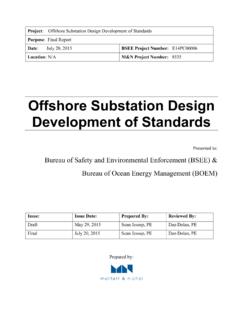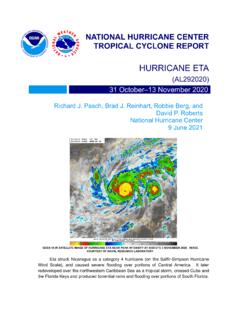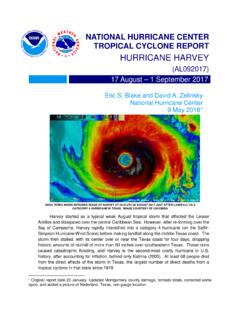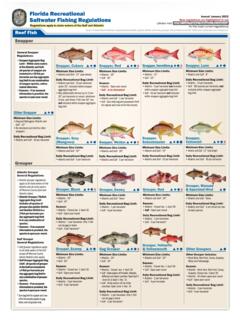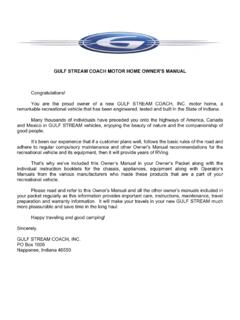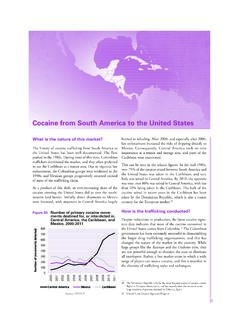Transcription of The Offshore Petroleum Industry in the Gulf of Mexico: A …
1 The Offshore Petroleum Industry in the gulf of mexico : A Continuum of Activities An oil Industry worker being lowered from a crane onto a satellite jacket on a production platform in the gulf of mexico , Lynda Miller (2006) Project concept, oversight, and funding for The Offshore Petroleum Industry in the gulf of mexico : A Continuum of Activities were provided by the Department of the Interior, Bureau of Ocean Energy Management, Environmental Studies Program, Washington, under purchase order number M12PX00067. This document has been technically reviewed by BOEM and it has been approved for publication. The views and conclusions contained in this document are those of the authors and should not be interpreted as representing the opinions or policies of the Government, nor does mention of trade names or commercial products constitute endorsement or recommendation for use.
2 This document was inspired by the Offshore Oil and Gas History Project. To download a PDF file of the associated Environmental Studies Program final report, go to the Department of the Interior, Bureau of Ocean Energy Management, Environmental Studies Program Information System website and search on OCS Study BOEM 2008-042. The document was developed with significant contributions from members of the project team at the Bureau of Applied Research in Anthropology, School of Anthropology, University of Arizona. Diane Austin (Principal Investigator) Lindsey Feldman (Research Assistant) Kelly McLain (Research Assistant) Special thanks to: The people of the gulf Coast region, especially southern Louisiana, who shared their stories for the Offshore Oil and Gas History Project Researchers for the Offshore Oil and Gas History Project Bureau of Ocean Energy Management, Environmental Studies Program The history of the Offshore oil and gas Industry in the gulf of mexico is marked by environmental, social, and political challenges.
3 As an extension of the vast Petroleum Industry , the Offshore Industry was and is influenced by the operational, technological, economic, and political issues that characterize that Industry . Once Offshore , though, the Industry faced new, unique circumstances. The technological challenges of Offshore exploration and production are perhaps the most obvious: constructing drilling rigs and platforms that can withstand wave action, developing techniques for cutting and welding metals underwater, and transporting materials and equipment over vast expanses of open water. Yet, the social challenges are equally daunting: attracting and maintaining a workforce able and willing to live on a small metal structure for weeks at a time or to work hundreds and even thousands of feet below the water s surface; organizing a workforce to take action and achieve results quickly and efficiently; and establishing a huge and oftentimes uncertain Industry amid isolated rural communities.
4 During the 1990s and into the next decade, the Bureau of Ocean Energy Management (BOEM; known at that time as the U. S. Minerals Management Service, or MMS) initiated a series of studies on the history of the Offshore oil and gas Industry in the gulf of mexico . The story of this Industry in the gulf is one of hard work, inventiveness, entrepreneurial spirit, and risk-taking that turned relatively isolated coastal communities into significant contributors to and global efforts to find and produce Petroleum from beneath the ocean. The history studies covered a range of topics from the evolution of Offshore technology to the Industry s effect on local communities, and also examined specific sectors such as fabrication and commercial oilfield diving.
5 At the time the studies began, little had been written about the Industry , its complexities, its many economic sectors, or its impacts on families, households, and coastal communities. Although Offshore Petroleum has assumed a high profile in the national development strategies of many countries around the world, the gulf of mexico remains the primary laboratory for technological innovation and regulatory practices. Efforts to analyze the political, social, and economic aspects of Offshore exploration and development can benefit from an understanding of what has happened there. This document was created to highlight some key findings of the history studies in order to increase that understanding (see the final page for references for the study reports and the location of the project archives).
6 Quotations and photographs were donated by study participants in the years indicated. The Offshore Petroleum Industry evolved from the onshore Industry and moved through wetlands and lakes and then across the outer continental shelf (OCS). The OCS is a legal and political unit that is under federal jurisdiction and generally extends from 3 to 200 nautical miles ( mi) from the coast. In the gulf of mexico , this Industry is a vast configuration of structures, vessels, companies, and people responsible for four primary phases of activity: exploration, development (drilling), production, and decommissioning. On the OCS, the process begins when a potential developer identifies where Petroleum might be and obtains a lease from the federal government.
7 The developer then drills exploratory wells to try and locate oil or gas. If successful, the well is temporarily sealed while preparations are made to extract the Petroleum from below the ocean floor. To produce Petroleum from the established well, the developer must have a method to manage the output and a system to transport it back to shore. Lastly, developers must have a plan to shut down operations after extracting as much of the Petroleum as possible. The Offshore Petroleum Industry in the gulf of mexico Graph: Annual Average Domestic Crude Oil Price based on Illinois Basin Crude Oil Prices, Illinois Oil and Gas Association (online at ). As you read the timelines on the following pages, keep in mind the fluctuation seen here, and note how these ups and downs affect global, national, and regional trends.
8 1 EXPLORATION 1953: Submerged Lands Act granted coastal states exclusive rights to 3 nautical miles from their coastlines. 1945: attorney general challenged California s right to Offshore submerged lands and the minerals that they held. 1983: President Ronald Reagan declared the Exclusive Economic Zone (EEZ), claiming for the United States rights to all waters up to 200 nautical miles from the coastline. 1993: First 3-D seismic survey in the gulf of mexico . 1999: Cumulative effect of earlier technological changes resulted in estimated 60% decrease in real cost of finding and producing oil compared to 10 years earlier. 1968: Two-dimensional (2-D) seismic surveys utilizing airguns began in the gulf of mexico . 1987: First three-dimensional (3-D) seismic surveys, a global event that set the stage for seismic surveying. I worked Offshore , ten days on and four days off, for about 15 years.
9 I stayed in exploration. After 23 years I decided I couldn t take my family with me anymore. And I was always jumping from one job to another. So I told [the company] I was gonna leave. And I stayed away for about a year and a half. And they called me back and asked me if I was ready to go back. Which made my wife real happy. Santo Rousso (2005), Seismic Developer 1930s-1950s: Near Shore 1960s-1980s: Deepwater 1990s-beyond: Ultra Deepwater Global Regional World War II Arab Oil Embargo Hurricanes Hurricanes Laying first generation seismic equipment, Houston Lejeune (2004) The search for oil and gas under the ocean begins when a seismic crew takes a vessel out to sea to scan the ocean floor to examine the rock and sediment formations. Seismic surveyors use sound waves that reflect off the bottom of the ocean floor and the rock layers inside the earth and travel back to recording equipment at the surface.
10 These waves allow scientists to see features below the earth s surface. The information from the seismic survey is fed into a computer and used to create three-dimensional (3-D) models of the earth s characteristics and identify pockets where oil and gas are likely to be found. Once those pockets are located, a mobile drilling platform with an exploratory drilling rig will drill temporary exploratory wells. The wells generally take 60 to 90 days to complete and produce core samples which geologists examine to determine the quality and quantity of Petroleum present. Navy surplus minesweepers used for seismic exploration, Jerry Cunningham (2002) Early 1930s: California oil producers applied to the government for Offshore oil and gas leases. 1930s: First seismic reflection surveys performed in oil exploration to delineate subsurface structure.




